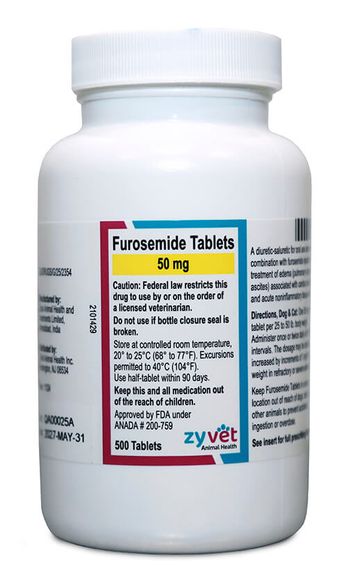
CVD remains most common cardiac disease in small, medium-sized dogs
Chronic valve disease (CVD), also called mitral valve disease or endocardiosis, is the most common form of acquired cardiac disease diagnosed in small- and medium-sized dogs. The mitral valve alone is affected in 60 percent of cases of chronic valve disease, whereas only the tricuspid valve is affected in 10 percent of cases. Thirty percent will have both the tricuspid and mitral valves affected. Endocardiosis is an age-related thickening of the mitral valve due to fibroblast proliferation and an increase in collagen and elastic fibers. The thickening of the mitral valve allows a regurgitant volume of blood to be forced from the high-pressure left ventricle into the low-pressure left atrium during systole. Over time, regurgitation can lead to progressive atrial and ventricular enlargement due to volume overload. Severe mitral regurgitation can lead to left-sided congestive heart failure and pulmonary edema formation. Long-term severe mitral regurgitation can lead to generalized heart failure. Right heart..
Chronic valve disease (CVD), also called mitral valve disease or endocardiosis, is the most common form of acquired cardiac disease diagnosed in small- and medium-sized dogs. The mitral valve alone is affected in 60 percent of cases of chronic valve disease, whereas only the tricuspid valve is affected in 10 percent of cases. Thirty percent will have both the tricuspid and mitral valves affected. Endocardiosis is an age-related thickening of the mitral valve due to fibroblast proliferation and an increase in collagen and elastic fibers. The thickening of the mitral valve allows a regurgitant volume of blood to be forced from the high-pressure left ventricle into the low-pressure left atrium during systole. Over time, regurgitation can lead to progressive atrial and ventricular enlargement due to volume overload. Severe mitral regurgitation can lead to left-sided congestive heart failure and pulmonary edema formation. Long-term severe mitral regurgitation can lead to generalized heart failure. Right heart failure is typically seen with end-stage chronic valve disease. Tricuspid valve endocardiosis alone typically does not develop into significant disease.
Clinical findings
Historical and physical exam findings for canines with chronic valve disease will vary depending on severity of disease. Typical signalment includes middle age to geriatric small-breed dogs. Those with mild chronic valve disease typically are asymptomatic. The heart murmur of mild mitral regurgitation is a soft high-pitched pansystolic heart murmur best auscultated over the apex at the left 5th intercostal space. The murmur may become coarse as the mitral regurgitation volume increases. Progression can occur over months to years. A palpable thrill may be noted over the left hemithorax in more advanced cases. A systolic murmur noted over the right apex is typically due to the mitral regurgitation radiating to the right hemithorax. Occasionally, a right-sided murmur may be due to significant tricuspid regurgitation, especially if pulmonary hypertension is present. Heart rates are higher in dogs with more severe disease and in dogs with congestive heart failure.
Clinical disease may manifest as coughing, lethargy, tachypnea and syncope. Differentials for small-breed dogs that present with a cough include bronchial disease, collapsing trachea, infectious tracheo-bronchitis and neoplasia. Thoracic radiographs are an important part of the evaluation for dogs that present with a cough.
Figure 1A Right lateral thoracic radiograph: Generalized enlargement to cardiac silhouette. Left atrial enlargement as noted tracheal elevation and main stem bronchus compression. The caudal dorsal lung fields appear clear.
Dogs with CVD may present with coughing due to left mainstem bronchus compression by an enlarged left atrium or due to a combination of bronchus compression and the formation of pulmonary edema (Figure 1a). Prominent pulmonary vasculature and increased opacity to the lung fields may be seen with left heart failure (Figure 1b). Dogs may develop right heart failure with ascites and pleural effusion. Typically this occurs in the later stages of disease.
Figure 1B DV thoracic radiograph: Orthogonal view of patient in top photo. Generalized enlargement to cardiac silhouette. A bulge is present in the area of the left auricular appendage. Soft tissue patchy alveolar pattern to caudal lung fields representing cardiogenic pulmonary edema and congestive heart failure.
Echocardiography is a useful tool in evaluating dogs with CVD. The changes that are evaluated with an echocardiogram include: left-sided enlargement, mitral valve structure, the degree of mitral regurgitation and evaluation of cardiac function. Left-atrial enlargement is in direct proportion to the severity of regurgitation. Systolic function is usually preserved in small-breed dogs. Myocardial failure may be more prevalent in large-breed dogs with endocardiosis. Mild cases typically have small jets of mitral regurgitation and no evidence of left-atrial or left-ventricular dilation. The mitral valve may appear nodular or focally thickened. Moderate mitral regurgitation causes a progressive increase in left-atrial and ventricular size, but preserved systolic function. The mitral valve appears thickened and may have evidence of prolapse into the left atrium. Severe cases of chronic valve disease have mitral regurgitation jets that fill greater than 50 percent of the left atrium (Figure 1c). Systolic and diastolic left ventricular dimensions are typically dilated and systolic function may begin to decline.
Figure 1C: Mitral regurgitation: Two-dimensional echocardiogram from the left apex demonstrating a four-chamber view with color Doppler flow. Severe mitral regurgitation is noted in the moderately dilated left atrium secondary to chronic valve disease.
Treatment
Dogs in active congestive heart failure, either right sided or left sided, require a potent diuretic such as furosemide. In late stages, when right heart failure and ascites is present, the addition of hydrochlorothiazide may be useful. The potential side effects of combining furosemide and hydrochlorothiazide are azotemia and hypokalemia. The addition of hydrochlorothiazide may allow a lower dose of furosemide that will minimize azotemia. If hypokalemia occurs, spironolactone can be added. Spironolactone is a weak diuretic and mainly used for its potassium sparing and aldosterone-blocking properties.
Persistent cough despite relief of congestive heart failure can be difficult to control. First line cough suppression drugs include Robitussin or Triaminic cough strips. These are mild over-the-counter cough suppressants. If these fail, narcotic-based products Lomotil, hydrocodone or butorphanol can be used. Lomotil is the least expensive of these narcotic drugs.
Initiation of ACE inhibitor treatment of CVD is debated among veterinary cardiologists. Studies performed in asymptomatic Cavalier King Charles Spaniels with CVD showed enalapril therapy did not delay the first onset of congestive heart failure. In the authors' practice, asymptomatic dogs with no evidence of left-atrial enlargement or mild left-atrial enlargement are not treated with ACE inhibitors. Dogs that are symptomatic and display lethargy may improve clinically on enalapril therapy. These cases are started on a four- to six-week trial of enalapril at 0.5 mg/kg PO SID. If owners appreciate clinical improvement, therapy is maintained. Typically ACE inhibitor therapy is reserved for dogs with CVD that have been in congestive heart failure and are currently being managed on furosemide therapy.
Pimobendan (Vetmedin) is a newer medication and is classified as calcium sensitizing agent and a phosphodiesterase inhibitor. Pimobendan is a potent inotropic agent due to its calcium sensitizing effects. The phosphodiesterase inhibition will cause peripheral vasodilation. The combined effect creates improvement in systolic function without increasing vasculature resistance. The authors have reserved its use for end-stage dogs with CVD that are symptomatic on diuretic and ACE inhibitor therapy. It is also useful in stabilizing patients with frequent bouts of congestive heart failure. Subjectively, owners notice an improvement in clinical signs and quality of life. Pimobendan usage may be cost prohibitive for some owners and long-term studies have yet to prove its efficacy. FDA permission is required to import the drug for use in veterinary patients.
Monitoring patients
Asymptomatic cases can be rechecked every six to eight months with a repeat history and physical exam. Periodic evaluation of ECG, thoracic radiographs and echocardiogram are dictated by changes in history and physical findings. Thoracic radiographs should be evaluated if the patient is coughing. Once congestive heart failure has occurred or severe left-atrial enlargement is present, echocardiography rarely adds significant clinical information. In the authors practice, compensated cases on stable cardiac medications are rechecked based on clinical signs.
In summary, CVD is the most common acquired form of cardiac disease diagnosed in small- and medium-sized canines. Asymptomatic cases with mild to moderate left-atrial enlargement should have further diagnostics based on history and physical examination changes. Thoracic radiographs should be evaluated for all dogs with a cough, since airway disease, collapsing trachea, congestive heart failure and mainstem bronchus compression all can cause coughing and require vastly different treatments.
Initiation of ACE inhibitor therapy is controversial in veterinary medicine and the authors recommend its usage in symptomatic dogs or those who have had CHF in the past. Pimobendan (Vetmedin) is a newer medication to help improve systolic function and subjectively its results are promising.
Carl Sammarco, BVSc, MRCVS, Dipl. ACVIM (Cardiology) joined Red Bank Veterinary Hospital in 2001. He previously served as a lecturer/assistant clinical professor at the University of Pennsylvania. He completed a residency in cardiology at the University of Pennsylvania in 1994 and is a veterinary graduate of the University of Liverpool in England.
Eric Anthony DeRose, DVM graduated from Kansas State University School of Veterinary Medicine in 2004. He completed an internship in small animal medicine and surgery at Veterinary Specialists of South Florida in 2005 and is now a first-year resident in cardiology at Red Bank Veterinary Hospital.
Newsletter
From exam room tips to practice management insights, get trusted veterinary news delivered straight to your inbox—subscribe to dvm360.






